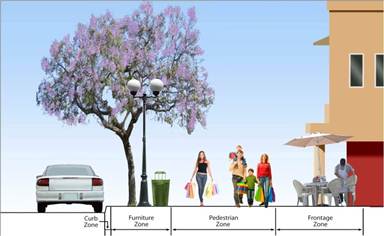
Funded by a Los Angeles County Department of Public Health Communities Putting Prevention to Work grant and the Luskin School of Public Affairs at the University of California, Los Angeles, the Model Design Manual for Living Streets (the Manual) offers guidance on innovative techniques and concepts in road design that emphasize active transportation and environmental sustainability. The Manual helps to promote specific street and intersection designs at the project level and to support broader visions for communities' transportation systems at citywide levels. Released for public use in October 2011, the Manual has been downloaded by 5,000 people nationwide and has received attention from the U.S. Department of Transportation's Office of the Secretary.
Development of the Model Design Manual for Living Streets was a multi-disciplinary effort. The project team, consisting of representatives from the fields of traffic engineering, transportation planning, land use planning, architecture, landscape architecture, public health, and sociology, worked together to produce the Manual. The Manual provides comprehensive guidance on all aspects of street design stemming from these disciplines, including transportation-related design guidance and chapters on streetscape ecosystems and introducing a sense of place and community into street systems. Members from key national and local organizations also helped to disseminate the Manual to their respective constituents.
The Manual serves as a template for local jurisdictions in California to begin updating their existing street design manuals. Many cities lack the resources to undertake a major revision of their existing manuals. With the introduction of the Manual, these cities can now customize and amend this guidance document to their own contexts. Many other places, including the Las Vegas Region; St. Paul, Minnesota; Broward County, Florida; and Whitby, Ontario, Canada are also developing their own manuals based on this document.
With its attention to a variety of topics, including pedestrian crossings, bicycle facilities, transit integration, land use, retrofitting suburbia, stormwater management, placemaking, and public engagement, the Model Design Manual for Living Streets serves as one of the most comprehensive design manuals in use today. For each topic area, the Manual also provides a list of additional resources that users can locate if they are seeking more specific information. The Manual's customizable aspect allows communities across the country to tailor the guidance to meet their specific needs and contexts and further promotes an accessible and user-friendly way to support active transportation and environmentally-sustainable design practices.
For more information, contact Madeline Brozen, University of California, Los Angeles, at MBrozen@publicaffairs.ucla.edu; Ryan Snyder, Ryan Snyder Associates, at Ryan@rsa.cc; or Suzanne Bogert, Los Angeles County Department of Public Health, at SBogert@ph.lacounty.gov.
